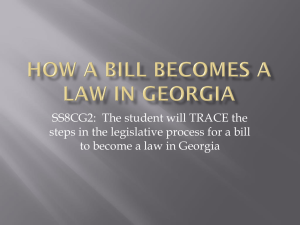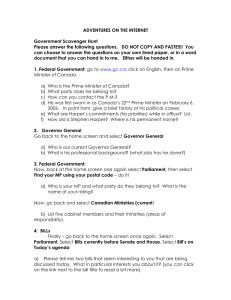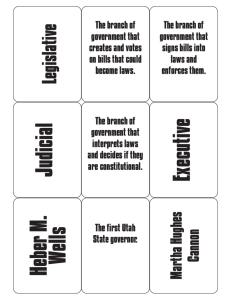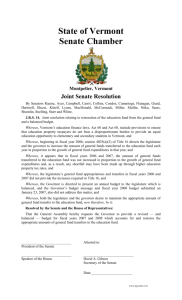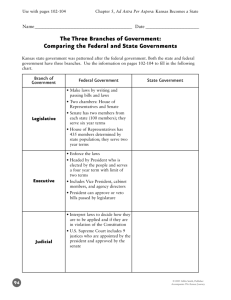Word file. - Hawaii Legislative Reference Bureau
advertisement
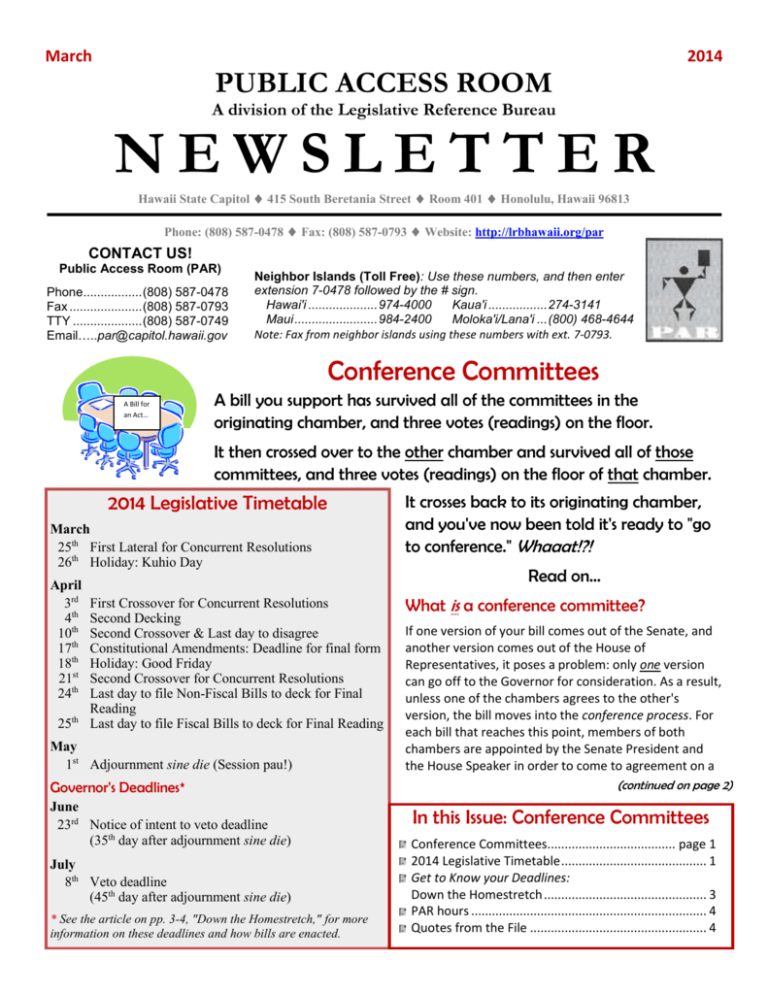
March 2014 PUBLIC ACCESS ROOM A division of the Legislative Reference Bureau NEWSLETTER Hawaii State Capitol 415 South Beretania Street Room 401 Honolulu, Hawaii 96813 Phone: (808) 587-0478 Fax: (808) 587-0793 Website: http://lrbhawaii.org/par CONTACT US! Public Access Room (PAR) Phone................. (808) 587-0478 Fax ..................... (808) 587-0793 TTY .................... (808) 587-0749 Email…..par@capitol.hawaii.gov Neighbor Islands (Toll Free): Use these numbers, and then enter extension 7-0478 followed by the # sign. Hawai'i .................... 974-4000 Kaua'i ................. 274-3141 Maui ........................ 984-2400 Moloka'i/Lana'i ... (800) 468-4644 Note: Fax from neighbor islands using these numbers with ext. 7-0793. Conference Committees A Bill forforan A Bill an Act… Act… A bill you support has survived all of the committees in the originating chamber, and three votes (readings) on the floor. It then crossed over to the other chamber and survived all of those committees, and three votes (readings) on the floor of that chamber. 2014 Legislative Timetable March 25th First Lateral for Concurrent Resolutions 26th Holiday: Kuhio Day April 3rd 4th 10th 17th 18th 21st 24th 25th First Crossover for Concurrent Resolutions Second Decking Second Crossover & Last day to disagree Constitutional Amendments: Deadline for final form Holiday: Good Friday Second Crossover for Concurrent Resolutions Last day to file Non-Fiscal Bills to deck for Final Reading Last day to file Fiscal Bills to deck for Final Reading May 1st Adjournment sine die (Session pau!) Governor's Deadlines* June 23rd Notice of intent to veto deadline (35th day after adjournment sine die) July 8th Veto deadline (45th day after adjournment sine die) * See the article on pp. 3-4, "Down the Homestretch," for more information on these deadlines and how bills are enacted. It crosses back to its originating chamber, and you've now been told it's ready to "go to conference." Whaaat!?! Read on… What is a conference committee? If one version of your bill comes out of the Senate, and another version comes out of the House of Representatives, it poses a problem: only one version can go off to the Governor for consideration. As a result, unless one of the chambers agrees to the other's version, the bill moves into the conference process. For each bill that reaches this point, members of both chambers are appointed by the Senate President and the House Speaker in order to come to agreement on a (continued on page 2) In this Issue: Conference Committees Conference Committees..................................... page 1 2014 Legislative Timetable .......................................... 1 Get to Know your Deadlines: Down the Homestretch ............................................... 3 PAR hours .................................................................... 4 Quotes from the File ................................................... 4 ("Conference Committees," continued from page 1) final version. The members are often called "managers" or "conferees." The conference committee chairs are usually the subject matter committee chairs for a given measure (typically the bill's first committee referral). Can the public testify? The public has had opportunities to testify during committee hearings. Conference, on the other hand, is the time when legislators work out compromises among themselves. They'll be crafting the final language and logistics of the bills. Meetings are open to the public though no testimony is accepted and, except for the budget bills, no new subject matter should be inserted. You may find it helpful to attend the meetings in order to follow the discussions and to provide input if asked for by a conferee. How can I stay informed about conference committee actions? The bill’s status sheet will be updated as its conferees are assigned and meetings scheduled. While the conference procedures*usually specify a minimum notice for posting notice of the first meeting, subsequent meetings can be convened just a few hours later. The procedures will specify what constitutes a required quorum for a vote to be taken. Legislators may serve on numerous conference committees and scheduling votes can be a challenge for legislative staff. Tip To make things easier to follow during conference, the Legislature's webmasters have set you up with some great tools. From the homepage, click on "Reports and Lists" and then "Conference Committee." You'll find easy links to help find conference notices, action sheets, and conferees. How can I advocate at this stage? - You may want to contact the conference members independently and concisely communicate what aspect of the bill you believe is a "must have" or an "absolutely not" to any final version they come up with. Tidbit Often the House Rules, Senate Rules, or Joint conference procedures* specify that a legislator who has voted against the measure will not be appointed to the conference committee. This is one of the reasons that a legislator in opposition to a measure may choose to vote 'aye with reservations' rather than against the measure. In this way, that person can still be eligible to serve on the conference committee, and can then attempt to have input on the bill's final form, or work to prevent a final compromise from being reached. - You may also want to ask your own Senator or Representative for assistance in influencing the legislation. - You may want to encourage constituents from the conferees' districts to communicate with their legislators about the legislation. What's the deadline for the conference committee to come to a decision? Final decking for non‐fiscal bills is April 24, 2014. For fiscal bills, it’s April 25, 2014. [Note: Fiscal bills are those that received referrals to the Senate Ways and Means committee and/or the House Finance committee.] This means any conference draft or decision on final form must be delivered to the House and/or Senate Chief Clerk by the deadline (placed on the Clerks’ “decks,” or desks). This allows the required 48‐hour notice for final readings to take place on April 29th or May 1st…the last two session days of the 2014 Regular Session. (Time flies!) * Conference committee procedures are usually agreed upon in early April. Once available, they usually are first posted under "Recent Updates" in the center of the Legislature's homepage (capitol.hawaii.gov), and filed on the "Legislative Information" page (click on the bar on the right hand side of the homepage). Page 2 March 2014 PAR Newsletter Get to Know your Deadlines: Down the Homestretch Many people are aware of the first phases of "How a Bill Becomes a Law" -- hearings, testimony, cross-over, passing 3 readings in each chamber -- but what happens down the homestretch? Assuming your bill has survived thus far, what's next? Conference Committee If the bill has been amended in the non-originating chamber (that is, if a House Bill has a Senate Draft or a Senate Bill has a House Draft), its next step is usually a conference committee. (Occasionally, the originating chamber will agree with the non-originating chamber's changes to a bill. In such instances, the originating chamber then votes on the changed bill, and if the bill passes, it can go directly to the Governor for his consideration.) The conference committee's function is to resolve the differences between the two chambers' versions of the bill. Each session, Senate and House leadership agree on joint rules governing Conference Committee operations. Basically, Senate and House leadership each appoint a lead chair, co-chairs and other members to the conference committees – a different conference committee for each bill that makes it to this phase. This usually includes a conferee from each standing committee the bill has passed through. What if they don't reach agreement? Then the bill is dead for the session. Final Decking A decision regarding the final form of the bill must be reported out of the conference committee by the Final Decking deadline – this year, that's April 24th for non-fiscal bills, and April 25th for the budget bills. This deadline allows members to review the bill in its final form forty-eight hours prior to voting on the measure. Adjournment sine die The final form of the bill needs to be voted on by the end of session, adjournment sine die – this year, that's scheduled to be May 1st. But we're not done! The bill still needs to be enacted into law. Enactment (Final Step to Becoming a Law)… continued on page 4 Join us! Art at the Capitol Friday, April 4, 2014 And PAR will be serving our Almost Famous Punch! March 2014 PAR Newsletter 4:30 p.m. Opening Program on 3rd Floor 5:00 - 7:00 p.m. Self-guided tour of the art in the offices Page 3 ("Down the Homestretch," continued from page 3) Enactment (Final Step to Becoming a Law) If a bill successfully passes through both chambers of the Legislature, it still needs to be enacted. The enactment procedure varies, depending on when the bill is delivered to the Governor and the Governor's subsequent action or inaction. If the bill is sent to the Governor on or before April 14, 2014 (i.e., before the last ten days of the session, excluding Saturdays, Sundays, holidays, and recess days), then… 1) If the Governor signs the bill within 10 days, it is given an act number and becomes law. 2) If the Governor vetoes the bill within 10 days, the bill does not become law unless the Legislature reconsiders the bill before adjournment sine die and overrides the veto with a 2/3 vote of all members in the House and a 2/3 vote of all members in the Senate. 3) If the Governor neither signs nor vetoes the bill within 10 days, it is given an act number and becomes law. If the bill is sent to the Governor after April 14, 2014 (i.e., later than ten days prior to adjournment sine die), then... 1) If the Governor signs the bill by July 8, 2014, it is given an act number and becomes law. 2) By June 23, 2014 (the 35th day after adjournment), the Governor must present the Legislature with a list of all bills he thinks he may veto. If he decides to veto a bill, he must inform the Legislature by the 45th day after adjournment (July 8, 2014). A vetoed bill does not become law unless: the Legislature reconvenes in special session before noon on the 45th day, July 8, 2014, and the bill is voted into law by a 2/3 vote of all members in the House and a 2/3 vote of all members in the Senate; or the bill is amended to meet the governor's objections; then passes one reading in each chamber; then is signed by the governor within ten days of being presented to him. 3) If the Governor does not sign or veto the bill by the 45th day after sine die, July 8, 2014, the bill is given an act number and becomes law. PAR! Remember, the Public Access Room (PAR) is here to assist you -- year round. Hours: We'll be open our extended hours (Monday-Friday, 8 a.m. - 7 p.m.) until the end of session, May 1st. After that, we'll be open Monday-Friday, 9 a.m. - 5 p.m., until the 2015 Regular Session starts up on Wednesday, January 21, 2015. Give us a call (587-0478) or email (par@capitol.hawaii.gov) if you've got questions, or want to know more. Quotes from the File . . . “Dripping water hollows out stone, not through force but through persistence.” - Ovid Page 4 March 2014 PAR Newsletter
